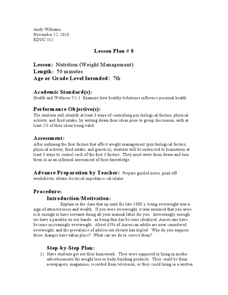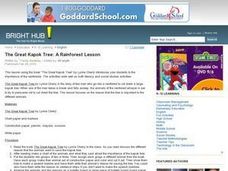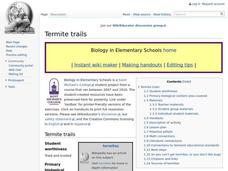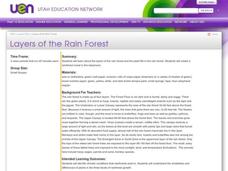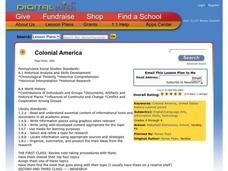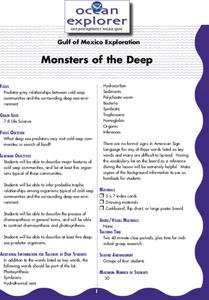Curated OER
Two-Dimensional and Three-Dimensional Shapes
First graders explore 2-dimensional and 3-dimensional shapes. In this geometry lesson, 1st graders examine the attributes of 2 -dimensional and 3-dimensional shapes. They also create the shapes as they build models. This lesson...
Curated OER
American Thanksgiving Through Time
Students explore five web sites in order to identify the various ways Thanksgiving has been celebrated in the past and how it is celebrated today. They consider the diversity of United States and this affects celebrations of the day.
Curated OER
Recyclers Revisited
Fifth graders observe their plant experiments that they started in a previous instructional activity and examine the role of decomposers in the nitrogen cycle. Two weeks after they set up a worm terrarium, they analyze any changes they...
Curated OER
Winter Survival
Students examine what animals need in order to survive. In this investigative lesson students play a "role" of an animal in winter.
Curated OER
Spiders
Students read books and make art projects dealing with spiders. In this spiders lesson plan, students learn about the different characteristics of spiders through listening, answering questions, and making spiders.
Curated OER
Nutrition (Weight Management)
Seventh graders explore nutrition and the effect it has by participating in class discussions. In this diet and exercise lesson, 7th graders analyze print advertisements and discuss how unrealistic their expectations are and how...
Curated OER
How to Catch a Fish
Students conduct an experiment to demonstrate the effects of different fishing methods. In this commercial fishing lesson students create posters and public announcements to share their information.
Curated OER
Our Interests
Third graders discover what mental health is. They discuss examples and draw pictures of themselves taking care of their mental health. They write a story about a time when they felt good about themselves.
Curated OER
Scales, Scutes, and Skins
Students identify the various adaptations of reptiles and amphibians. After distinguishing between reptiles and amphibians, students discuss the ways in which their adaptations aid in their survival. They participate in a hands on...
Curated OER
The Great Kapok Tree: A Rainforest Le
Learners explore the rainforest. In this language arts and social studies lesson plan, students discover the importance of the rainforests as they read The Great Kapok Tree and complete an activity.
Curated OER
Termite Trails
Young scholars observe termite trail-following behavior. In this termite trails lesson, students draw a circle or other shape approximately eight inches across with a ball point pen. Teacher taps out termites into the circle...
Curated OER
Ecological Pyramids
Students apply the ecological pyramids of numbers and biomass with an activity using topographic maps. For this trophic level lesson, students work in groups using a topographic map to determine the number of organisms that can live in...
Curated OER
A SALT WATER-Y WORLD
Young scholars observe a model of the distribution of the earth's water and compare the relative volumes and percentages of types of water on earth.
Curated OER
Wanted: Water!
Students determine what percentage of the Earth is water and how much water is needed by humans.
Curated OER
Layers of the Rainforest
Third graders identify, compare, and contrast the rainforests' climates. After reading Jane Yolen's Welcome to the Green House, they create a rainforest bulletin board.
Curated OER
"English Colonies"
Fifth graders create a tri- fold brochure around the topic of a colonial settlement that has been studied in the classroom for about 2 weeks prior to the workshop. They work with Publisher to create a brochure about a specific...
Curated OER
Wetland Adaptation
Fourth graders study the impact of the wetland environment on the migration of birds. They make a list of the important reasons on a large piece of paper to be posted in the classroom and point out the biggest wetland in the state (The...
Curated OER
What's Mongolia Really Like?
Students look at rural Mongolian nomadic culture through the eyes of a Peace Corps Volunteer and examine the dynamics of a people in transition. They give one important reason for migration from a rural to an urban setting and explain...
Curated OER
Wacky Water Critters
Students visit a local creek or stream. They collect water samples from the creek and observe and sort the "water critters" they find in the sample, observing smaller organisms under a microscope if necessary. They identify each organism...
Curated OER
Colonial America
Students discover the history of Colonial America by creating a class presentation. For this U.S. History lesson, students utilize the Internet to research one of 20 topics in which they will create a PowerPoint or other type of...
Curated OER
Monsters of the Deep
Learners describe major features of cold seep communities, and list at least five organisms typical of these communities. They infer probable trophic relationships among organisms typical of cold-seep communities.
Curated OER
My Friend, The Volcano
Students describe the positive impacts of volcanic activity on marine ecosystems. In this volcano lesson students explore the process that causes volcanic activity along the Mariana and Kermadec Island Arcs.
Curated OER
Shells
Sixth graders label diagrams of the 6 different classes of mollusks and explain the meaning of the labeled terms. They identify 8 common New Haven shells. They organize their own shell collection during this series of lessons.
Curated OER
Air Pressure
Students get a better understanding of air pressure and how it effects our daily lives.





